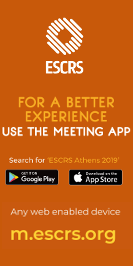Posters
(results will display both Free Papers & Poster)
From teleophthalmology to mobile ophthalmology: what it takes
Poster Details
First Author: I.Chatziangelidis GREECE
Co Author(s):
Abstract Details
Purpose:
Five years ago, i presented at the winter ESCRS meeting my prototype of the first European remote-controlled slit lamp. The project was entirely self-financed. I purchased a slit lamp and the hardware for motorized back-forth and left-right movements and slit angulation. I used an Apple iPhone, a 4G internet connection, and Apple FaceTime to stream videos. The purpose of this new tool was to make synchronous teleophthalmological examinations possible between Athens, Greece, and remote, underserved Greek islands. This is my Update.
Setting:
From the synchronous teleophthalmology project, a second new service was born. With the use of the available technology, part of the remote teleophthalmological unit , a complete ophthalmological service at patients home is made possible , with the same efficiency as in practice.
Methods:
I created a complete portable “teleophthalmological clinic in a suitcase,” containing a Vision Screener VS100 autorefractor (Welch Allyn), a Tono-Pen Avia (Reichert), an indirect ophthalmoscope (Keeler), a portable slit lamp, a portable pachymeter (DGH), a portable lens meter (Opto Hellas), 124 piece trial lenses and frame, and an iPad and iPhone with slit lamp and fundus camera adapter and completed my armamentarium with a series of apps, including optotype (Konan Medical Acuity), Amsler grid (Konan Medical Amsler grid), color testing (Konan Medical Color Dx) and visual field (Melbourne Rapid Fields). For data entry, i created my own EMR for iPad.
Results:
Since November 2016 , 325 patients in 463 home visits have been examined.
The five most common causes for the home visit were
Emergency calls 209 cases, 45.1% ,
Scheduled comprehensive examination 105 cases , 22.6%
Follow Up visits after initial examination 62 cases, 13.3%
Tonometry and Glaucoma evaluation 29 cases 6,2%
Refraction 23 cases, 4.9%
Age of patients varies from 9 to 105 y.o, with the majority between 77 and 96.
The percentage of patients who had a previous cataract surgery in any of the eyes is 43%.
Conclusions:
In the future, there will be an increasingly bigger demand for this kind of service. With the aging of the population in Europe, health issues correlated with older age are bound to increase, while isolation, limited mobility, cost of transportation and lack of family support will make access to health services more difficult and burdensome for individuals and the system.
Home visits and mobile ophthalmology are likely to be a more cost-effective option and more comfortable for the patient. The need is already much greater than we think.
Financial Disclosure:
... gains financially from product or procedure presented, ... is employed by a for-profit company with an interest in the subject of the presentation



